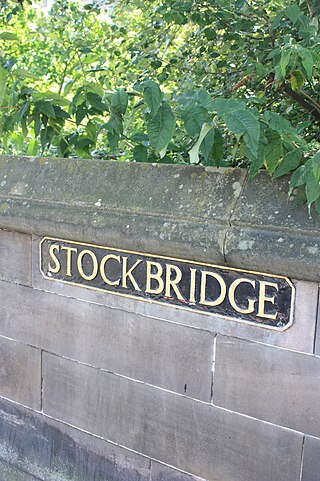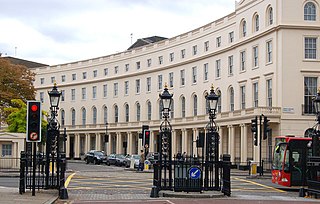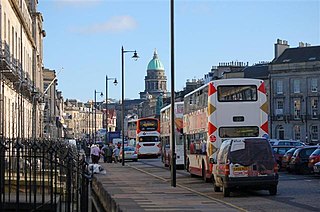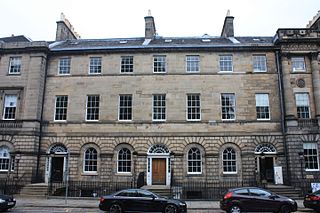
Fitzroy North is an inner-city suburb in Melbourne, Victoria, Australia, 4 km (2.5 mi) north-east of the Melbourne central business district, located within the Cities of Merri-bek and Yarra local government areas. Fitzroy North recorded a population of 12,781 at the 2021 census.

The Royal Botanic Garden Edinburgh (RBGE) is a scientific centre for the study of plants, their diversity and conservation, as well as a popular tourist attraction. Founded in 1670 as a physic garden to grow medicinal plants, today it occupies four sites across Scotland—Edinburgh, Dawyck, Logan and Benmore—each with its own specialist collection. The RBGE's living collection consists of more than 13,302 plant species, whilst the herbarium contains in excess of 3 million preserved specimens.

James Craig was a Scottish architect who worked mostly in lowlands of the country and especially his native city of Edinburgh. He is remembered primarily for his layout of the first Edinburgh New Town.

James Gillespie Graham was a Scottish architect, prominent in the early 19th century.
The New Town is a central area of Edinburgh, the capital of Scotland. It was built in stages between 1767 and around 1850, and retains much of its original neo-classical and Georgian period architecture. Its best known street is Princes Street, facing Edinburgh Castle and the Old Town across the geological depression of the former Nor Loch. Together with the West End, the New Town was designated a UNESCO World Heritage Site alongside the Old Town in 1995. The area is also famed for the New Town Gardens, a heritage designation since March 2001.

Charlotte Square is a garden square in Edinburgh, Scotland, part of the New Town, designated a UNESCO World Heritage Site. The square is located at the west end of George Street and was intended to mirror St. Andrew Square in the east. The gardens, one of the collection of New Town Gardens, are private and not publicly accessible.

Stockbridge is a district of Edinburgh, located north of the city centre, bounded by the New Town and by Comely Bank. The name is Scots stock brig from Anglic stocc brycg, meaning a timber bridge. Originally a small outlying village, it was incorporated into the City of Edinburgh in the 19th century. The current "Stock Bridge", built in 1801, is a stone structure spanning the Water of Leith. The painter Henry Raeburn (1756–1823) owned two adjoining estates, Deanhaugh and St Bernard's, which he developed with the assistance of the architect James Milne. Milne was also responsible for the fine St Bernard's Church (1823) in Saxe Coburg Street. Ann Street, designed by Raeburn and named after his wife, is a rare early example of a New Town street with private front gardens.

Broughton is an ancient feudal barony, today an area of Edinburgh, Scotland.

Park Crescent is at the north end of Portland Place and south of Marylebone Road in London. The crescent consists of elegant stuccoed terraced houses by the architect John Nash, which form a semicircle. The crescent is part of Nash's and wider town-planning visions of Roman-inspired imperial West End approaches to Regent's Park. It was originally conceived as a circus (circle) to be named Regent's Circus but instead Park Square was built to the north. The only buildings on the Regent's Park side of the square are small garden buildings, enabling higher floors of the Park Crescent buildings to have a longer, green northern view.

The West End is an affluent district of Edinburgh, Scotland, which along with the rest of the New Town and Old Town forms central Edinburgh, and Edinburgh's UNESCO World Heritage Site. The area boasts several of the city's hotels, restaurants, independent shops, offices and arts venues, including the Edinburgh Filmhouse, Edinburgh International Conference Centre and the Caledonian Hotel. The area also hosts art festivals and crafts fairs.

The Georgian House is an 18th-century townhouse situated at No. 7 Charlotte Square in the heart of the historic New Town of the city of Edinburgh, Scotland. It has been restored and furnished by the National Trust for Scotland, and is operated as a popular tourist attraction, with over 40,000 visitors annually.

John Chesser (1819-1892) was a nineteenth-century Scottish architect largely based in Edinburgh. He was described as "the prime exponent of terrace design at the time". A very high number of his works are now category A listed buildings, evidencing the quality of his work, particularly in the West End of Edinburgh.
Robert Reid Raeburn was a Scottish architect in the mid-19th century operating primarily in and around Edinburgh.

Thomas Brown was a Scottish architect in the early 19th century based in Edinburgh. He is best known for St. Mary's Church, Bellevue, Edinburgh, usually known as Bellevue Church.

The Regent, Royal and Carlton Terrace Gardens are private communal gardens in the New Town area of Edinburgh, EH7. They lie over a 4.8-hectare (12-acre) site on the east side of Calton Hill. The gardens have been listed on the Inventory of Gardens and Designed Landscapes as part of the New Town gardens heritage designation since March 2001. The gardens form some of the collection of New Town Gardens.

Queen Street is the northernmost east-west street in Edinburgh's First New Town. It begins in the east, at the Scottish National Portrait Gallery. It links York Place with the Moray Estate.

William Allan of Glen JP (1788–1868) was a 19th-century Scottish merchant who served as Lord Provost of Edinburgh from 1829 to 1831.
Bellevue is a district of Edinburgh, the capital of Scotland. It lies to the south east of Canonmills, west of Leith Walk and south of Leith, incorporating the easternmost extent of Edinburgh's New Town UNESCO heritage site. The area was formerly open fields which became the second and penultimate location of the Royal Botanic Garden in 1763 .

















